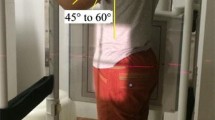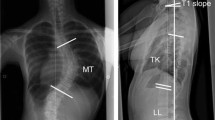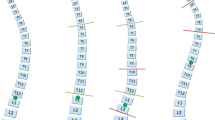Abstract
Purpose
To analyze the sagittal thoracic parameters of different types of progressive thoracic adolescent idiopathic scoliosis (AIS) patients and compare them with healthy adolescents.
Methods
115 AIS patients with main thoracic curves (Cobb: 59.4 ± 12.7) were prospectively compared with 116 healthy adolescents. The AIS and control (C) groups were homogeneous in terms of age and gender. Standing sagittal radiographs were analyzed for differences in T5–T12 kyphosis, T5–T8 and T9–T12 segmental kyphosis, the change between these two angles, and the double rib contour sign. Statistical analyses were performed using the χ 2, one-way ANOVA, Mann–Whitney U and Student’s t tests.
Results
The sagittal parameters of Lenke 1 curves did not differ from healthy adolescents (T5–T8: 17.1 ± 10 vs C: 16 ± 7; T9–T12: 6.3 ± 7 vs C: 7.9 ± 5; T5–T12: 23.9 ± 14 vs C: 23.9 ± 8). Compared with the controls, Lenke type 3 curves were globally more hypokyphotic (T5–T12: 18.9 ± 12 vs C: 23.9 ± 8, P = 0.027) due to a “lordosis” of the lower thoracic segment (T9–T12: 0.9 ± 10 vs C: 7.9 ± 5, P = 0.001). Type 2 curves tended to exhibit more pronounced upper thoracic kyphosis (T5–T8: 20.7 ± 12 vs C: 16 ± 7). Both types 2 and 3 require a marked TK changes in the transition between the upper and lower thoracic segments to compensate for global (T5–T12) kyphosis.
Conclusions
In this 2D analysis of moderate AIS, Lenke 1 curves exhibited normal thoracic sagittal parameters, which brings into question the effect of lordosis on the development of single thoracic curves. Lenke 3 curves exhibited lower thoracic segmental hypokyphosis, and the type 2 showed upper segmental hyperkyphosis. These results should be considered when planning a surgical strategy.



Similar content being viewed by others
References
Dickson RA, Lawton JO, Archer IA, Butt WP (1984) The pathogenesis of idiopathic scoliosis. Biplanar spinal asymmetry. J Bone Joint Surg Br 66(1):8–15
Mac-Thiong J-M, Labelle H, Charlebois M, Huot M-P, de Guise JA (2003) Sagittal plane analysis of the spine and pelvis in adolescent idiopathic scoliosis according to the coronal curve type. Spine (Phila Pa 1976) 28(13):1404–1409
Upasani VV, Tis J, Bastrom T, Pawelek J, Marks M, Lonner B, Crawford A, Newton PO (2007) Analysis of sagittal alignment in thoracic and thoracolumbar curves in adolescent idiopathic scoliosis: how do these two curve types differ? Spine (Phila Pa 1976) 32(12):1355–1359
Sucato DJ, Agrawal S, O’Brien MF, Lowe TG, Richards SB, Lenke L (2008) Restoration of thoracic kyphosis after operative treatment of adolescent idiopathic scoliosis: a multicenter comparison of three surgical approaches. Spine (Phila Pa 1976) 33(24):2630–2636
Lonner BS, Lazar-Antman MA, Sponseller PD, Shah SA, Newton PO, Betz R, Shufflebarger HS (2012) Multivariate Analysis of Factors Associated With Kyphosis Maintenance in Adolescent Idiopathic Scoliosis. Spine (Phila Pa 1976) 37(15):1297–1302
Roussouly P, Labelle H, Rouissi J, Bodin A (2013) Pre- and post-operative sagittal balance in idiopathic scoliosis: a comparison over the ages of two cohorts of 132 adolescents and 52 adults. Eur Spine J 22(Suppl 2):S203–S215
Somerville EW (1952) Rotational lordosis: the development of the single curve. J Bone Joint Surg Br 34-B(3):421–427
Roaf R (1960) Vertebral growth and its mechanical control. J Bone Joint Surg Br 42-B(1):40–59
Dickson RA (1985) Aetiology of idiopathic spinal deformities. Arch Dis Child 60(6):508–511
Deacon P, Flood BM, Dickson RA (1984) Idiopathic scoliosis in three dimensions. A radiographic and morphometric analysis. J Bone Joint Surg Br 66(4):509–512
Guo X, Chau WW, Chan YL, Cheng JC (2003) Relative anterior spinal overgrowth in adolescent idiopathic scoliosis. Results of disproportionate endochondral membranous bone growth. J Bone Joint Surg Br 85(7):1026–1031
Hayashi K, Upasani VV, Pawelek JB, Aubin CE, Labelle H, Lenke LG, Jackson R, Newton PO (2009) Three-dimensional analysis of thoracic apical sagittal alignment in adolescent idiopathic scoliosis. Spine (Phila Pa 1976) 34(8):792–797
Cidambi KR, Glaser DA, Bastrom TP, Nunn TN, Ono T, Newton PO (2012) Postoperative Changes in Spinal Rod Contour in Adolescent Idiopathic Scoliosis. Spine (Phila Pa 1976) 37(18):1566–1572
Propst-Proctor SL, Bleck EE (1983) Radiographic determination of lordosis and kyphosis in normal and scoliotic children. J Pediatr Orthop 3(3):344–346
Rigo M, Quera-Salvá G, Villagrasa M (2006) Sagittal configuration of the spine in girls with idiopathic scoliosis: progressing rather than initiating factor. Stud Health Technol Inform 123:90–94
Ries Z, Harpole B, Graves C, Gnanapragasam G, Larson N, Weintstein S, Mendoza-Lattes SA (2015) Selective Thoracic Fusion of Lenke I and II Curves Affects Sagittal Profiles But Not Sagittal or Spinopelvic Alignment: A Case-Control Study. Spine (Phila Pa 1976) 40(12):926–934
Stokes IA, Sangole AP, Aubin CE (2009) Classification of scoliosis deformity three-dimensional spinal shape by cluster analysis. Spine (Phila Pa 1976) 34(6):584–590
Sangole AP, Aubin CE, Labelle H, Stokes IA, Lenke LG, Jackson R, Newton P (2009) Three-dimensional classification of thoracic scoliotic curves. Spine (Phila Pa 1976) 34(1):91–99
Charles YP, Bouchaïb J, Walter A, Schuller S, Sauleau EA, Steib J-P (2012) Sagittal balance correction of idiopathic scoliosis using the in situ contouring technique. Eur Spine J 21(10):1950–1956. doi:10.1007/s00586-012-2356-2
Grivas TB, Dangas S, Samelis P, Maziotou C, Kandris K (2002) Lateral spinal profile in school-screening referrals with and without late onset idiopathic scoliosis 10 degrees-2 degrees. Stud Health Technol Inform 91:25–31
Willner S (1981) Spinal pantograph. A non-invasive technique for describing kyphosis and lordosis in the thoracolumbar spine. Acta Orthop Scand 52:525–529
Schlösser TP, Vincken KL, Rogers K, Castelein RM, Shah SA (2015) Natural sagittal spino-pelvic alignment in boys and girls before, at and after the adolescent growth spurt. Eur Spine J 24(6):1158–1167. doi:10.1007/s00586-014-3536-z
Kotwicki T (2002) Sagittal and transversal plane deformity in thoracic scoliosis. Stud Health Technol Inform 91:251–256
Grivas TB, Dangas S, Polyzois BD, Samelis P (2002) The Double Rib Contour Sign (DRCS) in lateral spinal radiographs: aetiologic implications for scoliosis. Stud Health Technol Inform 88:38–43
Janssen MM, Drevelle X, Humbert L, Skalli W, Castelein RM (2009) Differences in male and female spino-pelvic alignment in asymptomatic young adults: a three-dimensional analysis using upright low-dose digital biplanar X-rays. Spine (Phila Pa 1976) 34(23):E826–E832. doi:10.1097/BRS.0b013e3181a9fd85
de Jonge T, Dubousset J, Illés T (2002) Sagittal plane correction in idiopathic scoliosis. Spine (Phila Pa 1976) 27(7):754–760
Vedantam R, Lenke LG, Keeney JA, Bridwell KH (1998) Comparison of standing sagittal spinal alignment in asymptomatic adolescents and adults. Spine (Phila Pa 1976) 23(2):211–215
Bernhardt M, Bridwell KH (1989) Segmental analysis of the sagittal plane alignment of the normal thoracic and lumbar spines and thoracolumbar junction. Spine (Phila Pa 1976) 14(7):717–721
Lee CS, Chung SS, Kang KC, Park SJ, Shin SK (2011) Normal patterns of sagittal alignment of the spine in young adults radiological analysis in a Korean population. Spine (Phila Pa 1976) 36(25):E1648–E1654
Mac-Thiong JM, Labelle H, Berthonnaud E, Betz RR, Roussouly P (2007) Sagittal spinopelvic balance in normal children and adolescents. Eur Spine J 16(2):227–234
Lenke LG, Betz RR, Clements D, Merola A, Haher T, Lowe T, Newton P, Bridwell KH, Blanke K (2002) Curve prevalence of a new classification of operative adolescent idiopathic scoliosis: does classification correlate with treatment? Spine (Phila Pa 1976) 27(6):604–611
Archer IA, Dickson RA (1985) Stature and idiopathic scoliosis: a prospective study. J Bone Joint Surg Br 67(2):185–188
Janssen MM, Vincken KL, van Raak SM, Vrtovec T, Kemp B, Viergever MA, Bartels LW, Castelein RM (2013) Sagittal spinal profile and spinopelvic balance in parents of scoliotic children. Spine J 13(12):1789–1800
Dickson RA (1992) The etiology and pathogenesis of idiopathic scoliosis. Acta Orthop Belg 58(Suppl 1):21–25
Monazzam S, Newton PO, Bastrom TP, Yaszay B, Harms Study Group (2013) Multicenter comparison of the factors important in restoring thoracic kyphosis during posterior instrumentation for adolescent idiopathic scoliosis. Spine Deform 1(5):359–364. doi:10.1016/j.jspd.2013.06.002
du Peloux J, Fauchet R, Faucon B, Stagnara P (1965) The plan of choice for the radiologic examination of kyphoscolioses. Rev Chir Orthop Reparatrice Appar Mot 51(6):517–524
Author information
Authors and Affiliations
Corresponding author
Ethics declarations
Conflict of interest
No benefits in any form have been or will be received from a commercial party related directly or indirectly to the subject of this manuscript
Ethical standards
This study has IRB approval/Research Ethics Committee.
Rights and permissions
About this article
Cite this article
Pizones, J., Núñez-Medina, A., Sánchez-Mariscal, F. et al. Thoracic sagittal plane variations between patients with thoracic adolescent idiopathic scoliosis and healthy adolescents. Eur Spine J 25, 3095–3103 (2016). https://doi.org/10.1007/s00586-016-4400-0
Received:
Revised:
Accepted:
Published:
Issue Date:
DOI: https://doi.org/10.1007/s00586-016-4400-0




